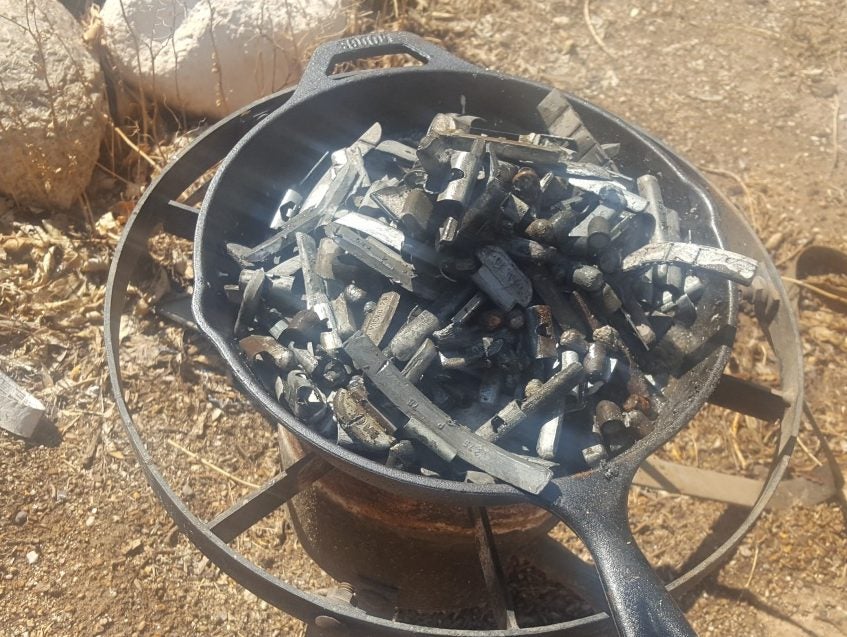Welcome to our second series regarding reloading! The good people of LYMAN have wanted to continue their partnership with TFB, and you the readers. The reloading series was a great challenge, and I enjoyed every minute of it. This series will be an entirely new challenge. My challenge will be to do series on an aspect of reloading I have never done and until recently knew little about. Casting bullets! Hot molten lead….what could possibly go wrong??

Behold my TFB patch next to my first ingot
With the wealth of knowledge and experience out there among our readers, I am confident we can go from start to finish with a solid end product. I have been at it for a few weeks and look forward to the discussion. So, those of you who have experience with this please comment. Here are a few things you will need to acquire:
Furnace
The furnace is what melts your lead prior to pouring lead into the bullet mold. The LYMAN Big Dipper Casting Furnace is what Lyman was good enough to send my way. For a beginner it is great. Believe it or not, it is 110v and gets plenty hot and more than enough volume to cast plenty of our beloved “PEWS”. The more advanced furnaces pour the hot lead out the bottom, but as a beginner, this is more than enough for my needs.

The Lyman Big Dipper, my little workhorse
Lead
This will be the basis of the entire first article. Finding a fair amount of scrap lead is NOT as easy as it sounds. I thought wheel weights were the way to go. Range pick up is an option. Lead can be toxic, and less toxic alternatives exist, so lead is much less prevalent in society. With a little searching, I did end up with over 25 pounds of lead ingots. Some may be wary of the health concerns. I believe it is just like dumping powder, if you are responsible and safe you will be fine. Basically don’t let it in your body, via ingesting, injecting, or inhaling.
Molds
You will need molds. There are ingot molds and bullet molds. The ingot molds are used to create your lead bricks. The process is necessary if you are starting from scrap lead. If you have a place to acquire lead ingots it is a skippable step. You will, however, need the bullet molds. Each mold is caliber and bullet weight specific. Molds are inexpensive and easy to come by.

There are a great variety of bullet molds on the market
Sizer and Lubricator
Following casting, you will need to size and lubricate the bullet. We will go over this, but I will probably go on a bit of a tangent at this point. You will need lube….you always need lube. Bullet lube NOT like “magic bullet” lube.
Manual
Yes, here I go again about the all-holy manual. The LYMAN casting handbook goes over the entire process and gives load data to your precious newborns. The entire process is explained in detail. There is a chapter written by a metallurgist that gets down and dirty, with the science.
A few others
If you go the option of using scrap lead, an old deep-frier base and a used up cast iron pan will be needed. You want to keep your furnace as clean as possible. Only lead ingots go into my furnace. I do all my casting outside (I recommend you only do it outside), but still had a fan to assist dissipating fumes. Use a space outside that has a fair amount of room without clutter so manipulating the molten lead will be done safely. These are only the basics, I will introduce a few of the other tools as we go.

Scrap lead being melted down to separate dirt and other metals
Conclusion
First off a huge thanks to LYMAN for continuing the partnership with TFB for this new series! They know TFB has the readers they want to reach out to. Second, a high five to Fire Captain B! A brother firefighter who came out to help with pics, and be my set medic.
Okay, readers, I am hoping for good conversation as we take on this new aspect of reloading. If you are interested in diving into this, there is a great forum with a huge amount of information, you can find it here; http://castboolits.gunloads.com/
Again this is a multipart series. The next installment will be out in a couple of weeks and will cover important setup and preparation. If you are interested in following along, make sure to get the below gear (or similar) as this is what will be used in this series (disclosure: the below are affiliate links that help support the site):
Here are some pics of the casting I did a couple weeks ago. As expected I made some mistakes. I believe I know what I was doing wrong, but let’s hear what you have to say. Be nice to the rookie caster!

I thought this a good pour, but it was not

Was not surprised for the first casting. What is your diagnosis?
Disclaimer; Lyman has provided me a number of the products used in this series
 Your Privacy Choices
Your Privacy Choices
